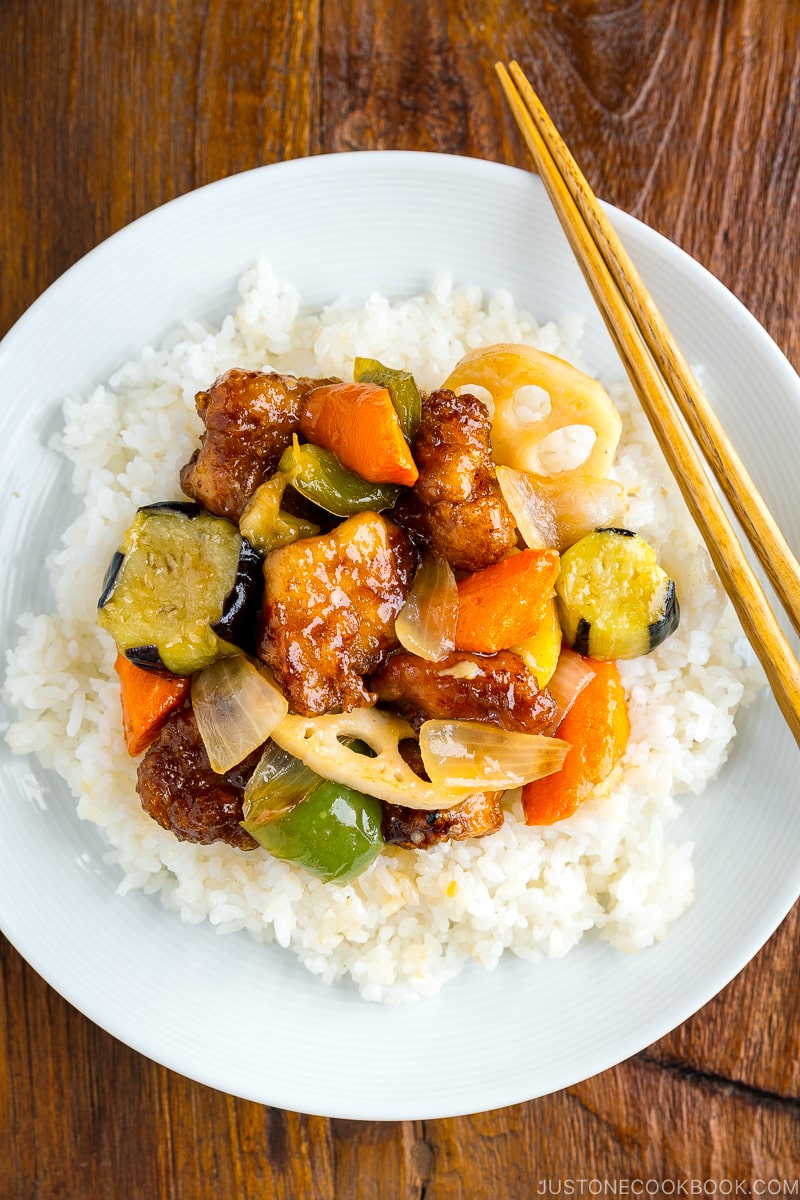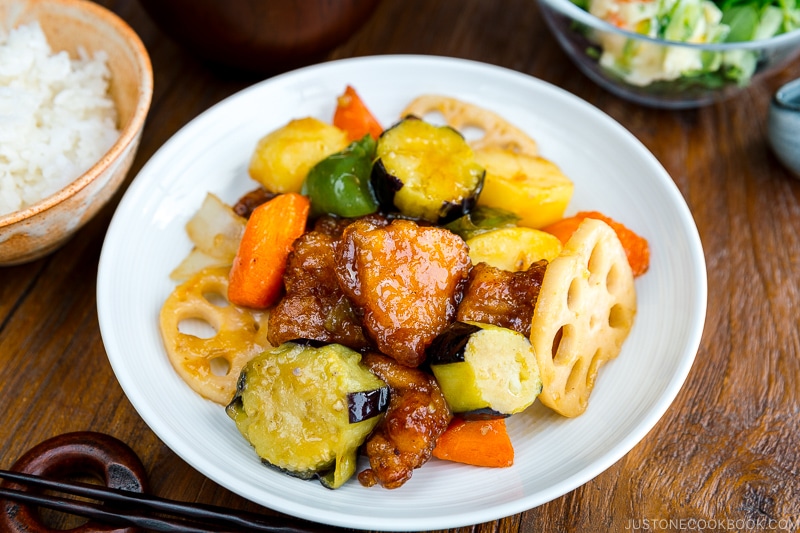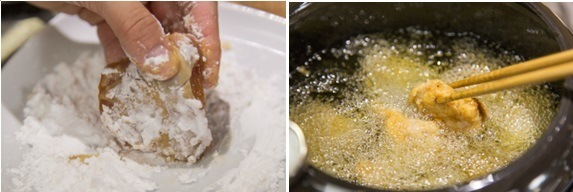This Chinese-style Sweet and Sour Chicken uses black rice vinegar to create a deep, malty, and savory sauce. Try my copycat recipe of the popular dish Tori Kurozu-an from the famous Japanese diner Ootoya 大戸屋.

Sweet and sour dishes from Chinese restaurants are really popular and my children love them whether they’re made with chicken or pork. Japanese-style sweet and sour chicken is a little different from the typical one you’ve tried, however.
What makes it Japanese-style? In this post, I’ll explain the key features and share my copycat recipe for Ootoya’s Sweet and Sour Chicken.
Table of Contents
What is Japanese Sweet and Sour Chicken?
This is a copycat recipe from a popular diner in Japan called Ootoya (大戸屋), which specializes in Japanese home-cooking dishes (katei ryori 家庭料理). In Japan, we refer to the sweet and sour sauce as amazu-an (甘酢あん), literary meaning “sweet vinegar gravy.” On Ootoya’s menu, this recipe is called Tori Kurozu-An (鶏と野菜の黒酢あん).
This sweet and sour chicken has been my favorite from Ootoya’s menu since I first tried this dish years and years ago. Here are the key features of this Japanese homestyle version of the dish:
- Uses Japanese black rice vinegar (黒酢, kurozu) – Black rice vinegar is an aged vinegar made from rice. It is less sour with a deeper flavor than regular rice vinegar and is milder than Chinese black vinegar.
- Omits ketchup – You won’t see the typical red color in Japanese-style sweet and sour sauce.
- Includes various vegetables – This version also contains several types of veggies not normally seen in Chinese-style sweet and sour chicken.
Ingredients for Sweet and Sour Chicken
- chicken thighs
- potatoes
- lotus root (renkon)
- carrot
- Japanese or Chinese eggplant
- onion
- green pepper
- potato starch or cornstarch
- neutral oil – for deep-frying
For the Marinade:
For the Black Vinegar Sauce:
- sugar
- apple cider vinegar
- soy sauce
- Japanese black vinegar (kurozu) – use half the amount you use Chinese black vinegar
- mirin
- water
- sake
- potato starch or cornstarch

How To Make Sweet and Sour Chicken
- Make the marinade. Grate the ginger and garlic clove. Combine with soy sauce and sake in a large bowl.
- Cut the chicken into bite-size pieces. Add to the marinade, coat well, and refrigerate for 10 minutes.
- Mix the black vinegar sauce. In a small bowl, combine the sauce ingredients and mix well to dissolve the sugar.
- Prep the vegetables. Cut the potatoes and carrot into small pieces and boil for 10 minutes until tender; drain. Peel and cut the lotus root and eggplant. Cut the onion and green pepper into wedges, then cut in half crosswise.
- Pat dry the vegetables with a paper towel and deep-fry in neutral oil until tender. Be careful not to overcook or undercook. Drain them on a wire rack or paper towel.
- Coat the chicken pieces in potato starch or cornstarch. Deep-fry until golden brown. Drain on a wire rack or paper towel.
- Toss together the deep-fried vegetables and chicken in a wok. Once reheated, add the black vinegar sauce and toss to combine. Transfer to a plate and serve.
Suage, a Japanese Deep-frying Technique
This recipe uses a Japanese cooking technique called suage (素揚げ, “su-ah-geh”). It means deep-frying without a coating of flour or batter. This technique is used mostly for vegetables, but sometimes meat, too.
The suage technique helps the ingredient keep its original flavor, color, and shape. By deep-frying vegetables for a short period of time, you can keep the crispness of the vegetables. This compares to stir-frying, which takes longer than deep-frying and sometimes cooks the veggies unevenly or makes them wilt and soften.
Packaged vs. Homemade Sweet and Sour Chicken
When I was in Japan last summer, I shared on Instagram a picture of this dish while dining there. A JOC reader in Australia left a comment saying that Ootoya actually sells a pre-made package of this special kurozu-an sauce. So the next time I passed by the restaurant, I bought two packages to try back at home.

After returning to the US, I made this dish at home with the packaged sauce, then tried to recreate this flavor. While testing my own recipe, I found out Ootoya actually shares the recipe for this dish online! So I made 3 batches for the taste test:
- Ootoya’s packaged sauce
- Ootoya’s online recipe
- My homemade version of Ootoya’s sauce
Our family had a serious tasting session for this recipe and one sauce won everyone’s votes for the best flavor. It was actually mine! My version was not that different from the original sauce, but in my humble opinion, I think mine has a better balance than the packaged one or the Ootoya’s recipe.
However, I still think the restaurant serves the best Tori Kurozu-An! For home cooking, though, my family agrees that my recipe was the best. I wrote down the exact measurements I used, so please try to be accurate for the best result.
If you have a chance, try this dish at one of Ootoya locations both in Japan and elsewhere like Singapore, China, Taiwan, Thailand, Hong Kong, Indonesia, and New York City in the US.

Wish to learn more about Japanese cooking? Sign up for our free newsletter to receive cooking tips & recipe updates! And stay in touch with me on Facebook, Pinterest, YouTube, and Instagram.

Sweet and Sour Chicken (Ootoya Tori Kurozu-An)
Video
Ingredients
- 2 chicken thighs (11 oz, 312 g)
- 3 potatoes
- 3 inches lotus root (renkon)
- ½ carrot
- 1 Japanese or Chinese eggplant
- ½ onion
- ½ green pepper
- ½ cup potato starch or cornstarch
- 3 cups neutral oil (for deep-frying)
For the Black Vinegar Sauce
- 4 Tbsp sugar
- 3 Tbsp apple cider vinegar
- 2 Tbsp soy sauce
- 1 Tbsp Japanese black vinegar (kurozu) (If you use Chinese black vinegar, use ½ Tbsp as it has a stronger flavor)
- 1 Tbsp mirin
- 1 Tbsp water
- 1 Tbsp sake
- 2 tsp potato starch or cornstarch
Instructions
- Gather all the ingredients.

- Make the marinade. Grate the ginger and collect 1 tsp ginger (with juice). Grate 1 clove garlic. Combine the ginger, garlic, 2 Tbsp soy sauce, and 1 Tbsp sake in a large bowl.

- Trim off and discard any excess fat from 2 chicken thighs, then cut the meat into bite-sized pieces and add them to the marinade. Cover and refrigerate for 10 minutes.

- Combine all the ingredients for the Black Vinegar Sauce: 4 Tbsp sugar, 3 Tbsp apple cider vinegar, 2 Tbsp soy sauce, 1 Tbsp Japanese black vinegar (kurozu), 1 Tbsp mirin, 1 Tbsp water, 1 Tbsp sake, and 2 tsp potato starch or cornstarch. Mix it well together.

- Peel and cut 3 potatoes in half. Peel and cut ½ carrot into small pieces. For the carrot, I use the rangiri cutting technique to create more surface space so that they will cook faster and look pretty.

- Potatoes and carrots take too long to cook by deep-frying alone; therefore, we boil them first for 10 minutes until they are tender. Drain and set aside.

- Peel and cut 3 inches lotus root (renkon) into ⅛-inch (3-mm) slices. Peel 1 Japanese or Chinese eggplant in a striped pattern and cut it into ½-inch (1.3-cm) slices.

- Cut ½ onion into wedges and cut the wedges in half crosswise. Cut ½ green pepper into wedges, then cut the wedges in half crosswise.

To Cook
- In a deep fryer or heavy-bottomed pot, add 3 cups neutral oil. Make sure you have at least 2 inches (5 cm) of oil in the pot. Depending on the size of your pot, you may need more or less oil. If you are new to deep-frying, read my post on How to Deep-Fry Food for helpful tips. Preheat the oil to 340ºF (170ºC). Using a paper towel, pat dry the vegetables. Then, add them to the oil and deep-fry until they‘re tender. Be careful not to overcook or undercook. When they’re done, drain them on a wire rack or paper towel.

- Next, coat the chicken pieces in ½ cup potato starch or cornstarch and deep-fry at 340ºF (170ºC) for 5 minutes or until golden brown. If the chicken is browning too quickly, lower the heat to make sure the chicken gets cooked through. Then, place the chicken pieces on a wire rack or paper towel and drain well.

To Add the Sauce and Serve
- When you‘re done deep-frying the chicken, reheat the wok and toss the deep-fried vegetables and chicken together. When they are re-heated evenly, pour the Black Vinegar Sauce over the chicken and vegetables and toss to combine. Transfer the Sweet and Sour Chicken to a plate and serve.

To Store
- You can keep the leftovers in an airtight container and store in the refrigerator for up to 3 days.









Amazing recipe, the whole family loves ootoya and love this recipe as well. Smells exactly like Ootoya and taste very close or even better. Served with just miso soup.
Hello Sabena! Aww. We are so happy to hear your family enjoyed Nami’s recipe!
Thank you for trying her recipe and for your kind feedback. Happy Cooking! 🤗
*Rating for only the sauce as have not made full recipe yet.
Intrigued by condiment Japanese Black Vinegar. So of course I ordered your recommended brand. It just arrived last night and couldn’t wait to try it. Your family has great palates…your version of the Sweet Sour sauce is amazing. I had quick meal of sautéed onion, & leftover meatballs warmed in the sauce over rice. So delicious. Thank you.
PS I’m making the above quickie meal with addition of green and red peppers for my toddler grandson’s Christmas dinner.
Hello, Joanne. We’re so glad you enjoyed Nami’s recipe!
We hope you and your family enjoy Christmas dinner. Merry Christmas.💞
Thank you for the recipe! I use lemon instead of apple cider vinegar and white Japanese vinegar instead of black one. I added it little by little and taste the sauce until it got the taste I like. I really doubt the process but it turned out great! My husband normally doesn’t like vegetables but finished it all. Only down side is there’re too many steps and too many kitchenware to wash for me! Hahaha. A little troublesome but love the dish anyway!
Hello, Wachansa! We’re delighted to hear that the hard process of making this dish was worthwhile, and that you and your husband enjoyed the dish!
Thank you for trying Nami’s recipe and for your kind feedback! 🤗
Thanks, Naomi! That’s very kind. I recently paid for a JOC Plus, and I can’t express how much I enjoy browsing your website! It’s 100% worth the money. 🙂
Hello, Wachansa. Aww. Thank you very much for your love and support.
We sincerely appreciate your kind feedback. We hope you continue to enjoy JOC’s website and Nami’s recipes. Happy cooking!
I made this with deep fried meatballs from your Tsukune recipe in place of the chicken. I also added crispy garlic in oil to the meat balls, they were great! Highly recommend if you have no chicken thighs in the fridge.
Oh, and yes deep fried meatballs tasted so good.
Hi Taro! Thank you for sharing your cooking experience with us!
Your deep-fried Tsukune idea sounds delicious, and we cannot wait to try it. Happy Cooking!
Hi Namoi san,
Thank you for your recipe. It tastes so good.
My lotus turns purple..is there any way to prevent the color change?
Hi Elise! Thank you very much for trying Nami’s recipe!
You can place the lotus root (Renkon) in the vinegar water. Vinegar:Water= 0.5 teaspoon:1 cup water
We hope this helps!
Wow, I cooked this and it was so delicious! I didn’t deep fry the veg, but I roasted the potatoes, carrots and some Jerusalem artichokes in the oven before adding to the rest of the stir fried veges. Also I used just normal Japanese vinegar. Better than Ootoya for sure!
Hi Renee! Yay!👏🏻 We are so happy to hear this turned out delicious! Thank you very much for trying this recipe and sharing your cooking experience with us!
I made this tonight and it’s super delicious! Thanks for sharing this recipe Nami!
My family loved it too. ❤️
Hi Jacqueline, Thank you very much for trying this recipe! We are so happy to hear your family enjoyed this dish!